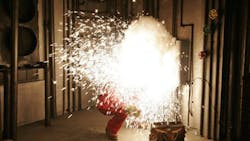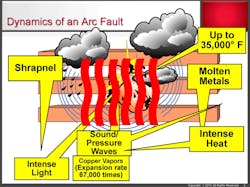It's easy to complain, “We did everything right!” after a catastrophe – particularly when an explosive arc blast destroys the evidence.
But when John Kay, senior specialist, medium voltage technologies at Rockwell Automation says it, he actually means it.
It’s a phrase he found himself repeating often at the America's Safest Companies conference in October when recounting an “up close and personal” encounter with an arc blast he experienced recently while performing a routine walkthrough at a customer facility.
“We did everything by the book,” he explained. ‘We did a pre-meeting of what we were going to do, we walked through every step we were going to do, we wrote down what we were going to do, we signed off what we were going to do… we did everything right.”
Even still, he said, when the electrician opened to door to the transformer box – which shouldn’t have touched or affected anything critical at all – the whole building exploded.
“It was just a huge ball of fire,” he recalled. “All I can remember is the sight of molten copper blowing through the smoke – it was like time stopped.”
His first thought watching that eruption approach, he remembered, was, “Where’s the electrician!?”
As a visitor not yet trained for the facility, Kay was standing back at a safe distance – part of his “doing everything right” protocol – but the electrician had his face just inches away from a 35,000 degree wave of molten copper and steel. He was at the dead center of an explosion of blinding light, a deafening boom and a blast of shrapnel traveling over 700 miles per hour.
He was in the same position that kills and disables about 2,000 workers per year, according to Kay. The same position that, every 30 minutes, injures another worker.
With arc blast temperatures ranging up to five times the heat of the sun and shrapnel bursts equaling the force of a .22 caliber bullet, this is a hard event to walk away from unscathed.
But that’s exactly what Kay’s electrician did.
“[The electrician] came running through the door at me, scared out of his wits, but totally safe,” he said. “He was fine. In fact, he didn’t even want to go to the hospital.”
The reason for that, he said, goes back to the premise: he did everything right.
“The company had done its arc flash studies,” Kay said. “They had all of the information labeled on [the electric box], so the electrician knew exactly what he was supposed to be wearing and, most importantly, he was wearing exactly what he was supposed to be wearing.”
So while the building nearly burned down around them, Kay said, “This guy didn't have a mark on him. No burns, no injuries, no nothing.”
Doing Your Homework
This outcome, as remarkable as it is, is becoming a far more common experience, Kay explained. Since about 2009, he said, arc flash incident rates – along with the injuries and fatalities they inflict – have leveled off dramatically.
“Electrical art flash incidents still continue,” he said. "The nice thing is they have baselined – kind of plateaued.”
That change, he said, is a result of an evolving set of standards that are quickly redefining the basic approach to electrical safety.
In his presentation at ASC, “What EHS Managers Should Know about NFPA Standards and Mitigating Electrical Safety Risk,” he explained that understanding these changing standards is critical continuing the positive safety trend while keeping the workplace complaint in the coming years.
New consensus standards from the National Fire Protection Association (NFPA), for example, now require all electrical safety programs to be audited on a cycle of three years or less, he explained. On top of that, electrical system studies must be completed every five years or less, and regular safety training and assessments for all electrical workers every three years or less. And all of these changes are subject to OSHA enforcement.
At the same time, arc-resistant clothing has evolved from eye protection and basic flame-retardant materials, to set ups that protect against the full danger of a blast, while new arc-resistant technologies are eliminating more and more of the danger before they start. NFPA and OSHA are already on the move to standardize and regulate those changes as well.
In the end, Kay said, the NFPA standards and OSHA regulations require vigilant, careful study at every level. Doing so can mean the difference between life and death – the difference between Kay’s electrician emerging unscathed from a burning facility and losing him in the rubble.
“These thing happen,” Kay explained. “You can do everything right and they still happen. But if you’ve done your homework and get them where you have a safe facility, you actually may save a person's life.”

